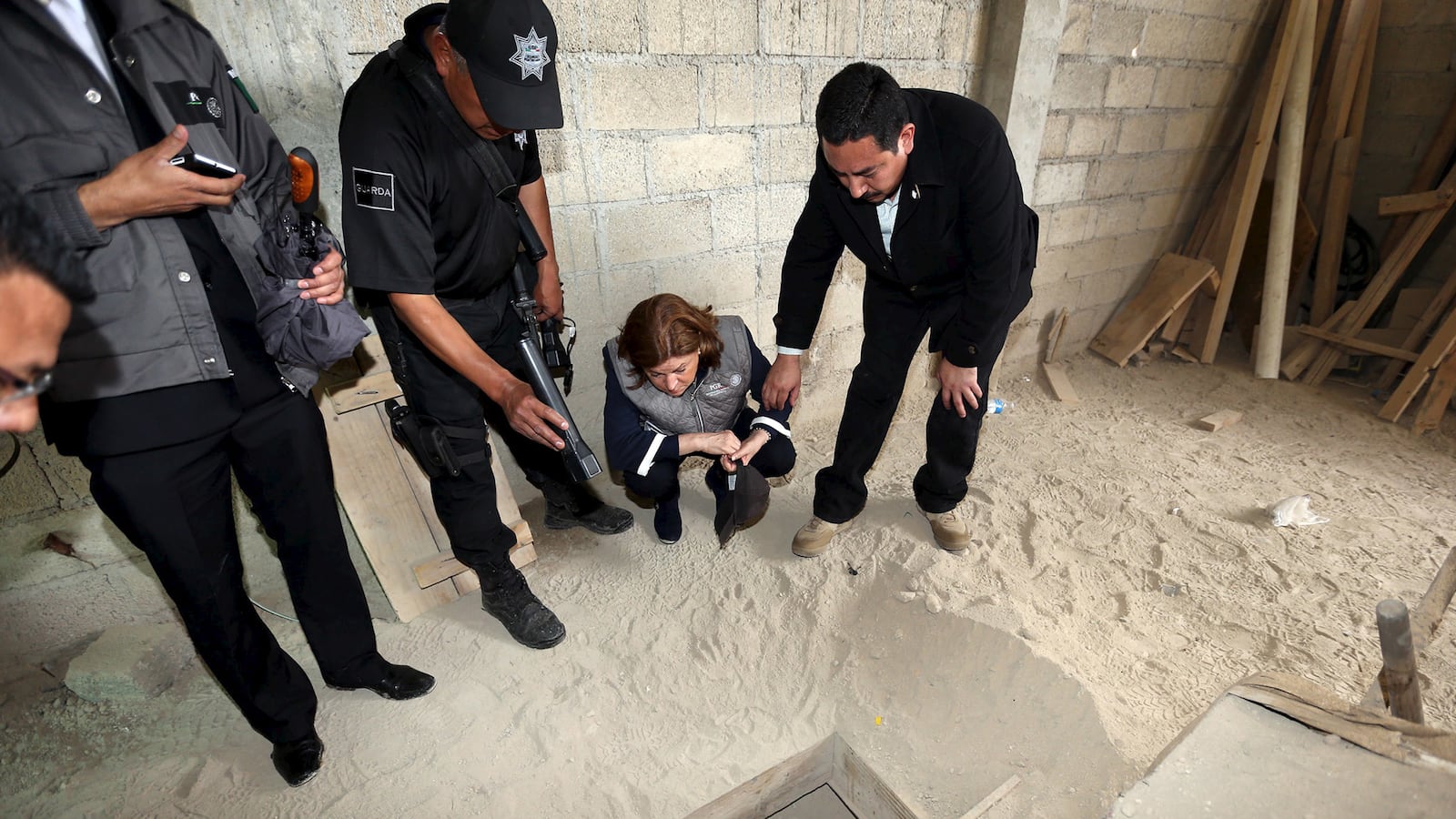El Chapo Guzman was no sooner behind bars than he was actively planning his great escape.
Proof of that came within four months of his capture, when a polite man and woman presumed to be a married couple purchased a scruffy patch of land a mile from the prison where the drug lord was consigned.
By several accounts, an elderly man then recruited a dozen locals to build a simple cinderblock house and an adjoining storage space on the property.
All of which was essentially a repeat of what El Chapo had done back in the late 1980s, when he prepared to dig his first tunnel.

As recounted in court papers, El Chapo detailed someone to buy a patch of land in the Mexican border town of Agua Prieta.
An architect named Felipe Corona-Verbera designed and built a house on the site. He then set about supervising the digging of a tunnel from inside the house.
The tunnel extended under the border to a warehouse in Douglas, Arizona. El Chapo set to moving massive quantities of drugs through it. A henchman named Miguel “Gordo” Martinez-Martinez later described to an Arizona federal court his boss’s excitement.
“Chapo said, ‘Gordo…now I have a fucking cool crossing. The architect Corona made a fucking cool tunnel,’” Martinez-Martinez testified.
El Chapo gave Martinez-Martinez instructions to relay to his Colombian suppliers.
“Tell them to send all the drugs that they can send because now we are going to bring a shitload of drugs.”
Martinez-Martinez told the court that the Colombians had a new name for El Chapo.
“They started calling him The Fast One, ‘El Rapido,’ because before the planes were arriving back in Colombia on the return, the cocaine was already in Los Angeles,” he testified.
Martinez-Martinez was appearing as a cooperating witness at this 2005 trial in which Corona-Verbera was charged with building that first tunnel.
By Martinez-Martinez’s account, the architect had started out building houses with cavernous underground “clavos”—stashes—for El Chapo, complete with bank-size vaults.
“In the bedroom, underneath the bed there was a hydraulic system in which the bed would raise,” Martinez-Martinez said. “People would enter through a ladder to put money away in the safes.”
The obvious next step was just to keep digging. The entrance to that first tunnel was concealed not with a bed but with a pool table.
El Chapo had moved tons of drugs and would have moved tons more had an underling not left the front door to the house ajar when the tunnel entrance was open and the pool table had been raised by the hydraulics.

“A policeman went by and saw the pool table on the ceiling,” Martinez-Martinez testified.
The tunnel was discovered and shut down, but El Chapo eventually built at least 75 more. He became known as the Lord of the Tunnels.
American authorities declared the tunnels and their concealed entrances “engineering marvels.” They have made a priority of tracking down the engineers who created them but so far have only managed to grab Corona-Verbera. He was convicted at the trial and sentenced to 18 years.
But other engineers kept at it, digging longer and ever more elaborately equipped tunnels.
If the pattern established by the first tunnel holds, then one of those engineers was the elderly man who supervised the building of the cinderblock house on the patch of land within sight of Altiplano prison’s towers and not far from a Mexican army base.
After the house was completed, the local workers were laid off. A small crew of outsiders moved into the house, likely veterans of other clandestine tunnels. They were apparently overseen by a hefty young man who drove a white van.
By Saturday night, the crew had apparently dwindled to a trio of watchmen. They were seemingly given little warning before the big moment came. Three uneaten sandwiches were left on a table inside the house, which the authorities found by following the tunnel leading from El Chapo’s cell.
In the aftermath, Mexican authorities announced that 30 prison workers and supervisors had been detained for questioning, among them the facility’s director.
And there were suspicions of complicity outside the prison walls. People who live in the vicinity of the house reported that the police had not swarmed into the area until six hours after the escape was discovered.
One local man reported that when he himself had done some building, he had been besieged by inspectors demanding to see his permits. He said he had seen nary a one appear at the cinderblock house during its construction.
Don’t see something, don’t say anything.
What you don’t see can’t get you killed.
When the locals spoke of the polite couple who bought the land a year ago, it became clear that El Chapo had not just begun planning his escape soon after he was arrested. He had put that plan in motion.
No wonder he had been fighting so hard to put off even a chance he might be extradited.
All these months, he must have known that the tunnel was extending ever closer to his cell.
One remaining question is how the excavators managed to be so precise when GPS will not work underground.
Cartel burrowers have been known to use compasses in working their way to a warehouse on the other side of the border.
But this tunnel was to the shower stall in cell 20 on corridor 2 in the special custody section.
One guess is that they used lasers, which can guide tunnelers to within centimeters of their destination.
However they did it, they had lots of practice. And they would not likely have tried it if they had not been confident of success.
Back in May, one of El Chapo’s sons, Ivan Guzman, had gone on Twitter with what might have seemed like just a bit of bravado.
“I bring armed people and I promise you the general will soon be back.”





